By Leen Randell
Updated: Jul 10, 2024
10 Best Herbal Decoctions For Bad Taste
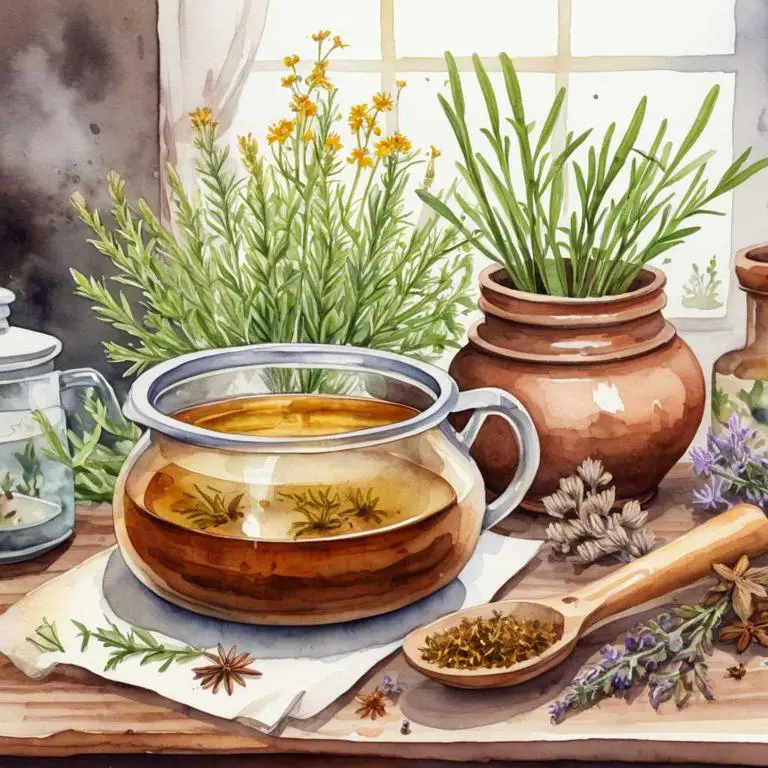
Herbal decoctions for bad taste are a type of natural remedy that helps to alleviate unpleasant mouth odors and tastes caused by poor oral hygiene, digestive issues, or certain medical conditions.
These decoctions work by stimulating saliva production, reducing inflammation, and eliminating bacteria that contribute to bad breath. Examples include ginger decoction, which has antibacterial properties that help freshen the breath, and turmeric decoction, which reduces inflammation in the mouth and gums.
By drinking these herbal decoctions regularly, individuals can enjoy improved oral health, increased confidence, and a renewed sense of well-being.
The following article describes in detail the most important decoctions for bad taste, including medicinal properties, parts of herbs to use, and recipes for preparations.
- 1. Mentha x piperita
- 2. Zingiber officinale
- 3. Sambucus nigra
- 4. Hyssopus officinalis
- 5. Calendula officinalis
- 6. Tilia cordata
- 7. Origanum vulgare
- 8. Cymbopogon citratus
- 9. Rosmarinus officinalis
- 10. Malva sylvestris
- What is the best combination of herbal decoctions to use for bad taste?
- What ailments similar to bad taste are treated with herbal decoctions?
1. Mentha x piperita
Peppermint decoctions helps with bad taste because of its natural antibacterial properties, which combat the underlying causes of foul breath.
The menthol in peppermint also helps to numb the mucous membranes in the mouth and throat, reducing inflammation and discomfort associated with bad taste. Additionally, peppermint's refreshing flavor can help mask unpleasant odors and leave a clean, invigorating sensation in the mouth.
By addressing the root causes and symptoms of bad taste, herbal peppermint decoctions provide a natural and effective solution for freshening breath and revitalizing oral health.

Medicinal Constituents
The list below shows the primary medicinal constituents in Mentha x piperita decoctions that help with bad taste.
- Menthol: It helps to reduce bad taste by acting as a local anesthetic, numbing the taste buds and temporarily alleviating the sensation of bad taste.
- Menthone: It has a decongestant and expectorant effect, which helps to relieve respiratory issues and associated bad tastes, such as postnasal drip or sinus congestion.
- Menthol-ester: It helps to reduce bad taste by acting as an anti-inflammatory agent, soothing the mucous membranes and reducing inflammation that may be contributing to the unpleasant taste.
Parts Used
The list below shows the primary parts of peppermint used to make decoctions for bad taste.
- Leaves: Fresh leaves are often used to make decoctions that aid in eliminating bad breath and bad taste due to their strong minty flavor.
- Roots: The roots of Mentha x piperita are used in decoctions to help reduce nausea and bad taste associated with digestive issues.
- Buds: The buds of the plant are used in decoctions to help alleviate bad taste and digestive problems due to their high menthol content.
Quick Recipe
The following recipe gives a procedure to make a basic peppermint for bad taste.
- Harvest fresh peppermint leaves in the morning when the essential oils are at their highest concentration.
- Chop 2 tablespoons of fresh peppermint leaves into smaller pieces to increase their surface area.
- Combine the chopped peppermint leaves with 1 cup of boiling water in a heat-resistant glass container.
- Steep the peppermint leaves in the boiling water for 5-10 minutes or until the liquid has cooled slightly.
- Strain the peppermint decoction through a cheesecloth or a fine-mesh sieve into a clean container.
2. Zingiber officinale
Ginger decoctions helps with bad taste because of its natural properties that stimulate saliva production, reducing dryness in the mouth.
The decoction's antibacterial and anti-inflammatory compounds also help eliminate bacteria and toxins that can cause unpleasant tastes and odors.
Additionally, ginger's digestive-boosting effects can aid in the elimination of toxins from the body through the digestive system, further improving overall oral health and freshening breath.

Medicinal Constituents
The list below shows the primary medicinal constituents in Zingiber officinale decoctions that help with bad taste.
- Gingerols: These sesquiterpene compounds, particularly [6]-gingerol, have been shown to have anti-inflammatory properties and have been found to reduce nausea and vomiting associated with bad taste.
- Shogaols: These pungent compounds are responsible for the warming sensation of ginger and have been found to have analgesic and anti-inflammatory properties that can help alleviate bad taste.
- Zingerone: This phenolic compound has been shown to have antioxidant and anti-inflammatory properties that can help reduce nausea and vomiting associated with bad taste.
Parts Used
The list below shows the primary parts of ginger used to make decoctions for bad taste.
- Roots: The roots of Zingiber officinale are also used in decoctions to address bad taste, as they contain the same active compounds as the rhyzome but are often easier to obtain.
- Stems: The stems of Zingiber officinale are sometimes used in decoctions to address bad taste, although they are less commonly used than the rhyzome or roots.
Quick Recipe
The following recipe gives a procedure to make a basic ginger for bad taste.
- Harvest 20-30 fresh zingiber officinale rhizomes with a sharp knife to prevent damage and bruising.
- Wash the harvested rhizomes in cool water to remove any dirt and debris thoroughly.
- Slice the washed rhizomes into thin pieces using a sharp knife to increase surface area.
- Boil 4 cups of water in a large pot and add 1 teaspoon of sliced zingiber officinale for every cup.
- Simmer the mixture for 10-15 minutes to release active compounds and then strain it through a cheesecloth.
3. Sambucus nigra
Elder decoctions helps with bad taste because they possess anti-inflammatory and antioxidant properties that soothe and protect the mucous membranes in the mouth and throat.
These membranes can become inflamed or irritated due to various factors, leading to a change in taste perception. Elder decoctions' natural compounds help calm this inflammation, reducing discomfort and restoring the senses to their normal functioning state.
This allows individuals to regain their sense of taste and enjoy food and drinks without the unwanted aftertaste or sensation.
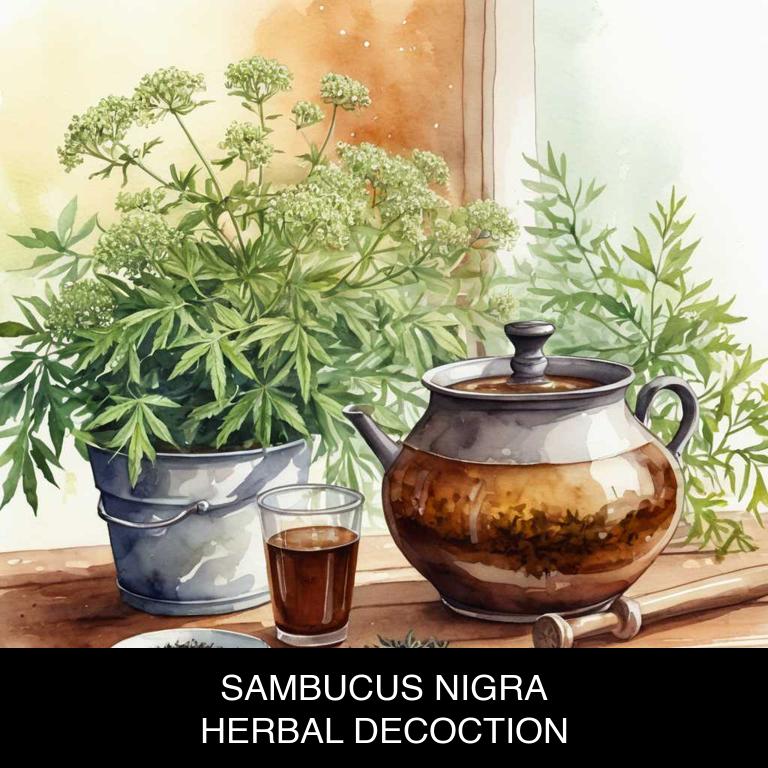
Medicinal Constituents
The list below shows the primary medicinal constituents in Sambucus nigra decoctions that help with bad taste.
- Flavonoids: These compounds help by reducing inflammation in the mouth and throat, which in turn can alleviate bad taste caused by conditions like stomatitis or oral thrush.
- Phenolic acids: These acids have antimicrobial properties that can help combat infections in the mouth, such as fungal or bacterial infections, which can cause bad taste.
- Sambunigrin: This glycoside has been shown to have antimicrobial and anti-inflammatory properties, which can help alleviate bad taste caused by infections or inflammation in the mouth.
Parts Used
The list below shows the primary parts of elder used to make decoctions for bad taste.
- Flowers: They have a strong, bitter taste that can help mask bad tastes in the mouth.
- Leaves: Similar to flowers, the leaves have a strong, bitter flavor that can be used to disguise unpleasant tastes.
- Fruits: The berries of Sambucus nigra are often used to make decoctions for bad taste, as they have a strong, bitter flavor that can help mask unpleasant tastes in the mouth.
Quick Recipe
The following recipe gives a procedure to make a basic elder for bad taste.
- Harvest fresh sambucus nigra flowers and berries in large quantities at peak ripeness for optimal potency.
- Clean the harvested flowers and berries thoroughly by rinsing them under cold running water for 10 minutes.
- Combine 1 part sambucus nigra flowers and berries with 4 parts water in a large pot to create a decoction.
- Boil the mixture for 10-15 minutes on medium heat then reduce the heat to a simmer for another 20-30 minutes.
- Strain the decoction through a cheesecloth or a fine-mesh sieve to remove the plant material and discard the solids.
4. Hyssopus officinalis
Hyssop decoctions helps with bad taste because of its natural antibacterial and anti-inflammatory properties.
The decoction has been traditionally used to soothe sore throats, reduce swelling in the mouth and tongue, and eliminate bad breath caused by bacterial infections or inflammation. As a result, it can help to neutralize unpleasant tastes and odors, leaving your mouth feeling fresher and cleaner.
Additionally, hyssop's anti-inflammatory properties may also help to reduce gum inflammation and alleviate pain associated with bad taste.
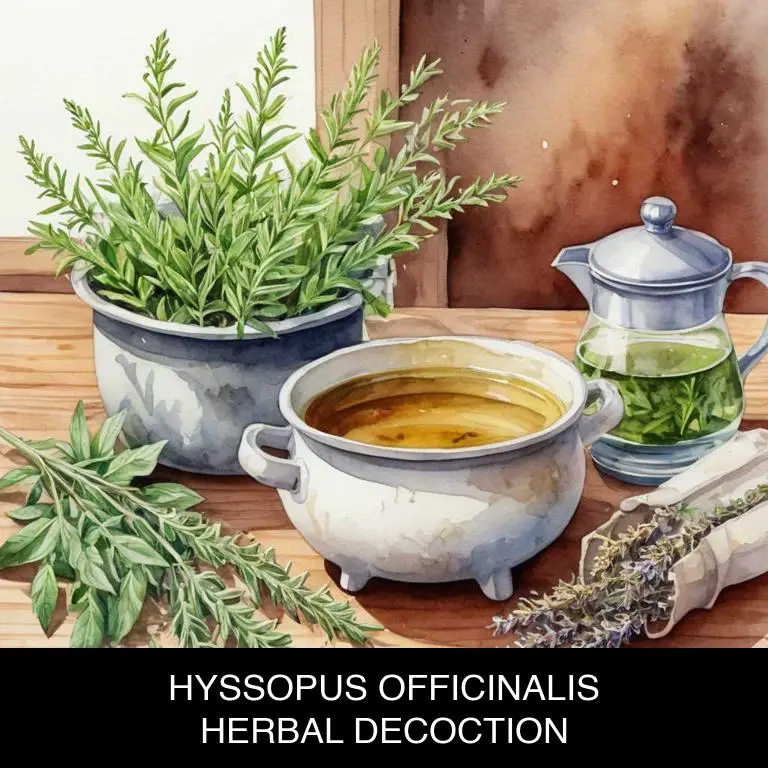
Medicinal Constituents
The list below shows the primary medicinal constituents in Hyssopus officinalis decoctions that help with bad taste.
- Terpinen-4-ol: This monoterpene acts as an antimicrobial and antifungal agent, helping to eliminate bacteria and fungi that may be contributing to bad taste or odor.
- Bornyl acetate: As a monoterpene, bornyl acetate has been shown to have anti-inflammatory properties, which may help soothe and calm the mouth, reducing bad taste and discomfort.
- Rosmarinic acid: This phenolic compound exhibits antioxidant and anti-inflammatory properties, which may help reduce inflammation and kill bacteria in the mouth, leading to a fresher and cleaner taste.
Parts Used
The list below shows the primary parts of hyssop used to make decoctions for bad taste.
- Leaves: Used for their antiseptic and anti-inflammatory properties to reduce bad breath and gum inflammation.
- Flowers: Used to mask bad taste due to their sweet and aromatic flavor.
- Roots: Used for their bitter taste, which can help counteract and mask the bad taste, while also providing some medicinal benefits.
Quick Recipe
The following recipe gives a procedure to make a basic hyssop for bad taste.
- Gather 1/2 cup of dried hyssopus officinalis flowers in a clean container.
- Combine the flowers with 1 quart of boiling water in a heat-resistant container.
- Steep the mixture for 5 to 7 minutes or until the liquid has cooled slightly.
- Strain the liquid through a cheesecloth or a fine-mesh sieve into another container.
- Allow the decoction to cool completely before storing it in the refrigerator for up to 24 hours.
5. Calendula officinalis
Pot marigold decoctions helps with bad taste because of its ability to soothe and calm the mucous membranes in the mouth, throat, and digestive tract.
The anti-inflammatory properties of pot marigold help reduce inflammation and irritation that can cause a bad taste or sensation in the mouth. Additionally, its antibacterial properties help combat bad breath-causing bacteria, leaving the mouth feeling fresh and clean.
By promoting healing and reducing inflammation, pot marigold decoctions can help restore a pleasant and healthy sense of taste.

Medicinal Constituents
The list below shows the primary medicinal constituents in Calendula officinalis decoctions that help with bad taste.
- Flavonoids: These plant compounds help to reduce inflammation and soothe irritated mucous membranes, which can contribute to bad taste.
- Triterpenoids: These compounds have antimicrobial properties that can help to eliminate the source of the bad taste, such as bacteria or fungi in the mouth.
- Phenolic acids: These plant compounds have antioxidant and anti-inflammatory effects that can help to reduce the severity of bad taste by protecting the mucous membranes and promoting healing.
Parts Used
The list below shows the primary parts of pot marigold used to make decoctions for bad taste.
- Flowers::
- Leaves::
- Roots::
Quick Recipe
The following recipe gives a procedure to make a basic pot marigold for bad taste.
- Harvest fresh or dried calendula officinalis flowers from a trusted source to ensure quality.
- Clean and dry the flowers to remove any dirt or debris thoroughly.
- Combine 1 tablespoon of dried flowers with 1 cup of boiling water to create a decoction.
- Steep the mixture for 10 to 15 minutes to allow the active compounds to infuse.
- Strain the decoction through a cheesecloth or a fine-mesh sieve to remove the solids completely.
6. Tilia cordata
Littleleaf linden decoctions helps with bad taste because of its antiseptic and anti-inflammatory properties.
The herbal remedy has been shown to reduce inflammation in the mouth and throat, which can cause unpleasant tastes and odors. Additionally, it contains flavonoids that have antibacterial properties, helping to combat the growth of harmful bacteria that can contribute to bad breath.
By soothing and cleansing the oral cavity, littleleaf linden decoctions can restore a fresh and clean taste sensation.
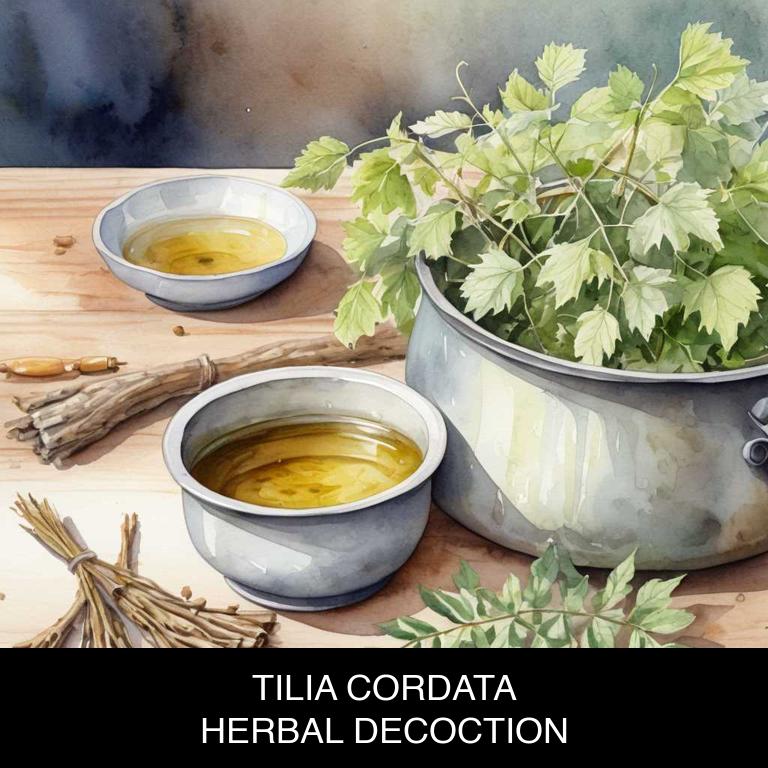
Medicinal Constituents
The list below shows the primary medicinal constituents in Tilia cordata decoctions that help with bad taste.
- Flavonoids: These compounds help with bad taste by reducing inflammation and soothing the mucous membranes in the mouth, throat, and digestive tract, thereby alleviating unpleasant sensations and taste disturbances.
- Triterpenoids: Triterpenoids, particularly ursolic acid, may help with bad taste by exhibiting antimicrobial and anti-inflammatory properties, which can aid in reducing the presence of pathogens and inflammation that contribute to bad taste.
- Phenolic acids: Phenolic acids, including caffeic acid and ferulic acid, may help with bad taste by exhibiting antioxidant and anti-inflammatory properties, which can help protect the mucous membranes and reduce oxidative stress that may contribute to bad taste.
Parts Used
The list below shows the primary parts of littleleaf linden used to make decoctions for bad taste.
- Buds: They are used to make decoctions due to their mild, sweet flavor that can mask bad tastes.
- Leaves: The leaves are used to make decoctions as they have a mild, slightly sweet taste that helps to neutralize bad tastes.
- Flowers: The flowers are used to make decoctions because of their delicate, floral flavor that can effectively mask unpleasant tastes.
Quick Recipe
The following recipe gives a procedure to make a basic littleleaf linden for bad taste.
- Harvest fresh leaves of tilia cordata in the morning after the dew has evaporated for optimal potency.
- Clean and dry the leaves thoroughly to prevent contamination and preserve their medicinal properties.
- Steep one teaspoon of dried tilia cordata leaves in one cup of boiling water for 5-10 minutes.
- Strain the decoction through a cheesecloth or fine mesh to remove the solids and achieve clarity.
- Store the cooled decoction in a glass container in the refrigerator for up to 24 hours.
7. Origanum vulgare
Wild marjoram decoctions helps with bad taste because it has a natural ability to stimulate digestion and eliminate toxins from the mouth.
The antibacterial properties of wild marjoram work to reduce the presence of harmful bacteria that can cause bad breath, while its anti-inflammatory properties help to soothe and calm the mucous membranes in the mouth.
As a result, wild marjoram decoctions can help to restore the natural balance of flora in the mouth, leaving you with fresher and more pleasant breath.
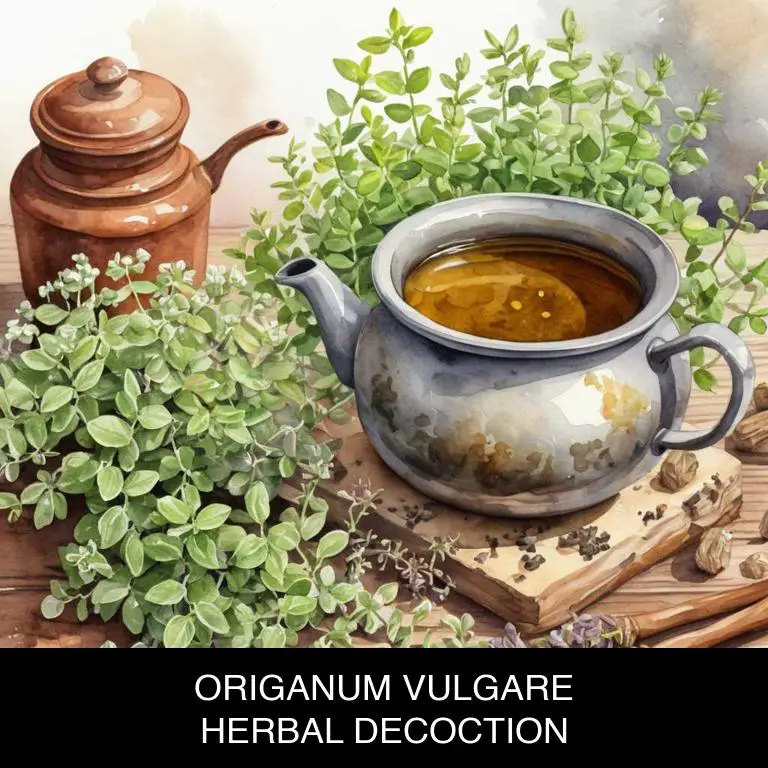
Medicinal Constituents
The list below shows the primary medicinal constituents in Origanum vulgare decoctions that help with bad taste.
- Bornyl acetate: This terpene has been found to exhibit antimicrobial properties, which can help reduce the presence of volatile sulfur compounds in the mouth associated with bad breath.
- Caryophyllene oxide: This sesquiterpene oxide has shown antioxidant and antimicrobial properties, which can help neutralize free radicals and reduce the growth of bacteria that contribute to bad breath.
- Rosmarinic acid: This phenolic compound has been found to exhibit antimicrobial and anti-inflammatory properties, which can help reduce the inflammation and bacterial growth in the mouth associated with bad breath.
Parts Used
The list below shows the primary parts of wild marjoram used to make decoctions for bad taste.
- Leaves: Used for their flavor and aroma, as they contain essential oils that can help mask unpleasant tastes.
- Stems: Used to add a bitter flavor, which can help counteract bad tastes in the mouth and promote digestion.
- Roots: Used for their earthy flavor and potential digestive benefits, helping to balance out bad tastes and promote overall gut health.
Quick Recipe
The following recipe gives a procedure to make a basic wild marjoram for bad taste.
- Harvest fresh origanum vulgare leaves and flowers in the morning after the dew has dried.
- Dry the freshly harvested origanum vulgare in a warm place for 7 to 10 days.
- Chop 10 grams of dried origanum vulgare into smaller pieces for easier infusion.
- Steep 1 teaspoon of chopped origanum vulgare in 1 cup of boiling water for 5 to 10 minutes.
- Strain the decoction through a cheesecloth or fine mesh to remove the solids.
8. Cymbopogon citratus
Lemongrass decoctions helps with bad taste because of its natural antibacterial and anti-inflammatory properties.
The citral oil present in lemongrass has been shown to reduce the growth of bacteria that can cause bad breath, such as Helicobacter pylori. Additionally, lemongrass's antimicrobial properties help soothe and calm the mouth, reducing inflammation and discomfort associated with bad taste.
By drinking a warm lemongrass decoction, you can effectively eliminate bad taste and freshen your breath naturally.
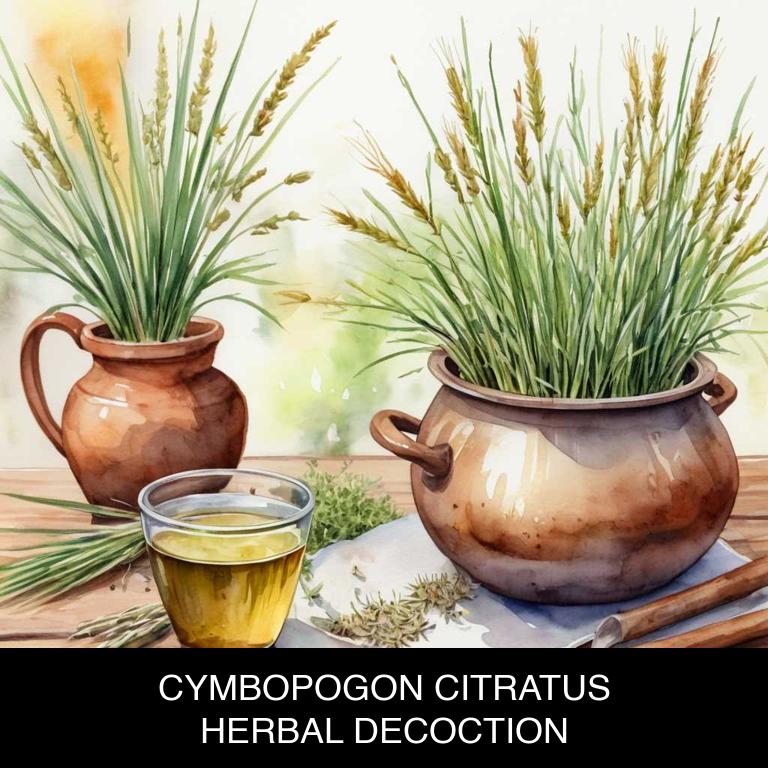
Medicinal Constituents
The list below shows the primary medicinal constituents in Cymbopogon citratus decoctions that help with bad taste.
- Geranial: It has antimicrobial properties that help reduce the bacterial load in the mouth, thereby alleviating bad taste.
- Linalool: Its anti-inflammatory and antimicrobial properties help soothe and protect the mucous membranes in the mouth, reducing inflammation and bad taste.
- Caryophyllene oxide: It exhibits antimicrobial and anti-inflammatory properties that help combat infections and inflammation in the mouth, leading to a reduction in bad taste.
Parts Used
The list below shows the primary parts of lemongrass used to make decoctions for bad taste.
- Leaves: Used to make decoctions for bad taste due to their high concentration of citronella oil, which has anti-inflammatory and antimicrobial properties that help soothe the stomach and mouth.
- Rhyzomes: Used to make decoctions for bad taste due to their ability to stimulate digestion and relieve nausea, which helps alleviate bad taste and other gastrointestinal issues.
- Stems: Used to make decoctions for bad taste due to their content of volatile oils, which can help reduce inflammation and alleviate bad taste, nausea, and other digestive issues.
Quick Recipe
The following recipe gives a procedure to make a basic lemongrass for bad taste.
- Measure 1 tablespoon of dried cymbopogon citratus leaves and place them in a clean glass container.
- Combine the measured leaves with 2 cups of water in a medium-sized saucepan.
- Bring the mixture to a gentle boil over medium heat for 5-7 minutes.
- Remove the saucepan from the heat and let it steep for 10-15 minutes.
- Strain the decoction through a fine-mesh sieve into a clean glass bottle and discard the solids.
9. Rosmarinus officinalis
Rosemary decoctions helps with bad taste because of its natural antibacterial properties that work to eliminate bacteria-causing unpleasant odors in the mouth.
The antioxidants present in rosemary also help to reduce inflammation and soothe the mucous membranes, which can become irritated by an imbalance of oral bacteria.
As a result, rosemary decoctions can leave your breath feeling fresh and clean, banishing bad taste and leaving you with a sense of confidence in your oral hygiene.
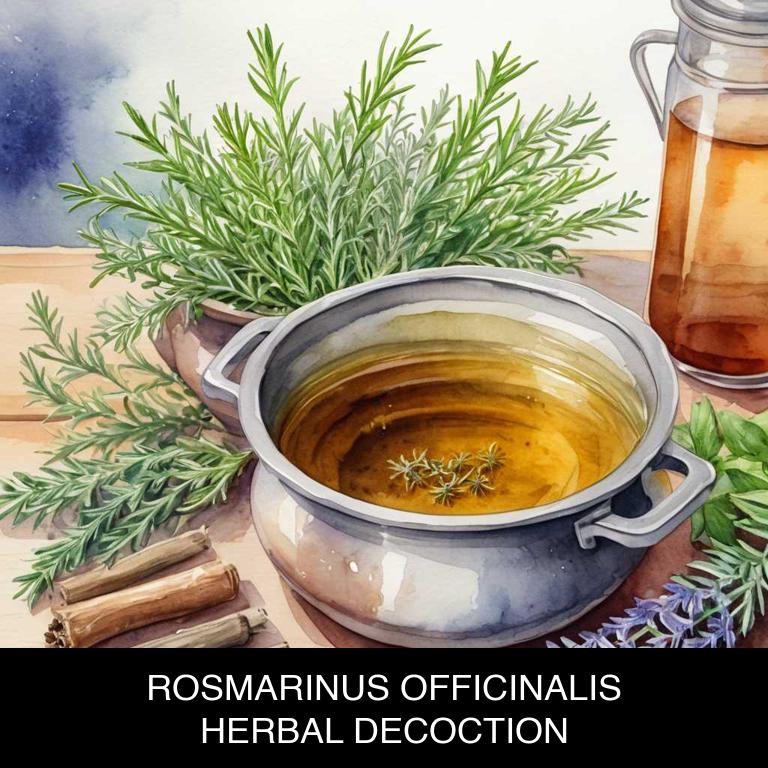
Medicinal Constituents
The list below shows the primary medicinal constituents in Rosmarinus officinalis decoctions that help with bad taste.
- Rosmarinic acid: A phenolic diterpenoid compound that helps with bad taste by reducing inflammation in the mouth and throat, thereby alleviating unpleasant sensations associated with bad taste.
- Carnosic acid: A phenolic diterpenoid that has antioxidant and anti-inflammatory properties, which aid in neutralizing the causes of bad taste and promoting a healthy oral environment.
- Bornyl acetate: A terpene that has antimicrobial properties, helping to eliminate bacteria and other pathogens that may contribute to bad taste, while also providing a fresh and pleasant aroma.
Parts Used
The list below shows the primary parts of rosemary used to make decoctions for bad taste.
- Leaves: Used to make decoctions for bad taste due to their aromatic properties.
- Stems: Used to make decoctions for bad taste due to their ability to aid digestion and alleviate nausea.
- Flowers: Used to make decoctions for bad taste due to their pleasant, aromatic flavor.
Quick Recipe
The following recipe gives a procedure to make a basic rosemary for bad taste.
- Measure out 1 teaspoon of dried rosmarinus officinalis leaves for every 8 ounces of water.
- Combine the rosmarinus officinalis leaves with 8 ounces of boiling water in a heat-resistant cup.
- Allow the mixture to steep for 5-10 minutes to release the herbal properties and flavors.
- Strain the liquid using a fine-mesh sieve or cheesecloth to remove the solids.
- Discard the solids and transfer the decoction to a clean container for storage and later use.
10. Malva sylvestris
Mallow decoctions helps with bad taste because it has anti-inflammatory properties that soothe the mucous membranes in the mouth and throat, reducing inflammation and discomfort associated with bad breath.
The decoction's demulcent nature also coats and protects the irritated tissues, providing relief from irritation and promoting a healthy environment for good oral health.
By calming the irritants, mallow decoctions allow the natural pH balance of the mouth to return, eliminating bad taste and leaving the mouth feeling fresh and clean.
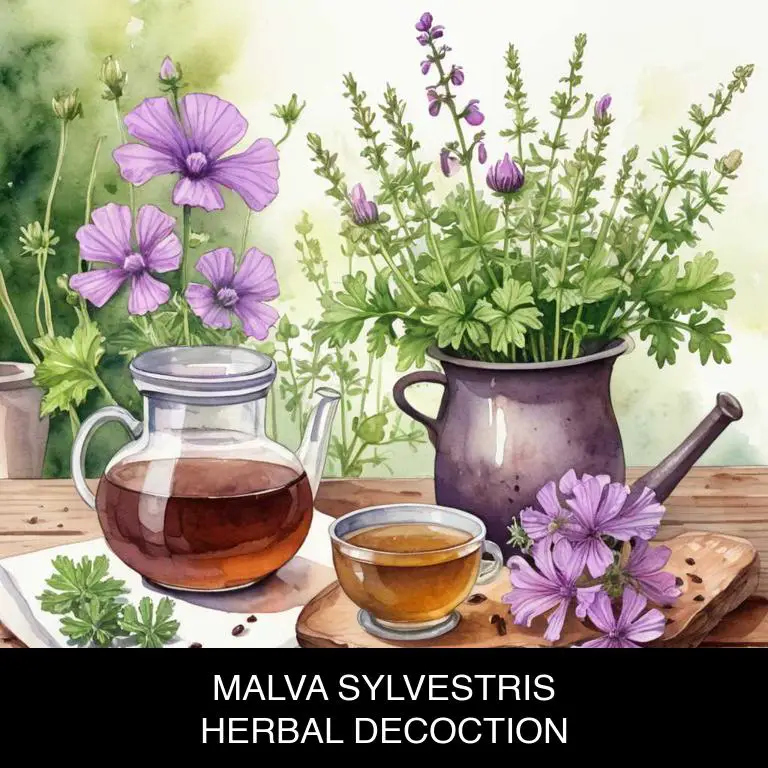
Medicinal Constituents
The list below shows the primary medicinal constituents in Malva sylvestris decoctions that help with bad taste.
- Mucilages: Mucilages help with bad taste by forming a protective film on the mucous membranes, soothing and calming the irritated tissues and reducing inflammation, which in turn reduces the unpleasant sensation associated with bad taste.
- Flavonoids: Flavonoids, specifically quercetin, contribute to the anti-inflammatory and antioxidant properties of Malva sylvestris, reducing inflammation and oxidative stress in the oral cavity, which can help alleviate bad taste.
- Tannins: Tannins help with bad taste by their astringent properties, which can help reduce inflammation and dry out excess mucus, thereby reducing the unpleasant sensations associated with bad taste.
Parts Used
The list below shows the primary parts of mallow used to make decoctions for bad taste.
- Leaves: Used due to their astringent properties, which can help to reduce the sensitivity of the tongue and mask unpleasant tastes.
- Flowers: Utilized for their sweet and soothing flavor, which can help to neutralize bad tastes and provide a pleasant aftertaste.
- Roots: Employed for their slightly bitter and astringent properties, which can help to counterbalance strong or unpleasant flavors.
Quick Recipe
The following recipe gives a procedure to make a basic mallow for bad taste.
- Harvest 1-2 bunches of fresh malva sylvestris leaves and flowers in early morning when dew is still present.
- Wash the harvested malva sylvestris leaves and flowers in cold running water to remove any dirt or debris.
- Combine 1-2 teaspoons of dried malva sylvestris leaves and flowers with 1 liter of boiling water to create a decoction.
- Steep the decoction for 5-10 minutes to allow the malva sylvestris properties to infuse into the water.
- Strain the decoction through a cheesecloth or a fine-mesh sieve into a clean container to separate the liquid.
What is the best combination of herbal decoctions to use for bad taste?
The best combination of herbal decoctions that help with bad taste is a blend of Peppermint (Mentha piperita), Ginger (Zingiber officinale), and Licorice Root (Glycyrrhiza glabra).
Peppermint helps to freshen breath and reduce inflammation, while Ginger's anti-inflammatory properties soothe the mouth and throat. Licorice Root's natural sweetness and anti-inflammatory properties balance out the taste and provide relief from irritation.
This combination can be steeped as a tea or added to water for a refreshing and healing drink.
What ailments similar to bad taste are treated with herbal decoctions?
Ailments similar to bad taste that are treated with herbal decoctions are mouth sores, gum inflammation, and toothaches.
Decoctions made from herbs such as Turmeric, Ginger, and Neem have anti-inflammatory properties that help soothe and reduce pain in the oral cavity. Additionally, decoctions of herbs like Sage and Calendula can also be used to treat bad breath and dry mouth.
These herbal remedies are natural, non-invasive, and effective ways to manage oral health issues.